2022 Benchmark Report Part 1: How Work Gets Done in Law Firms
By Nicole Black

Introduction
The practice of law is unique, and the demands of representing your clients can be never ending. There’s always something to be done between court dates, non-stop phone calls, and ever-pressing deadlines. As a result, it’s not always easy to keep up, and you can feel overwhelmed sometimes.
While you can’t remove stress from your practice, you can mitigate it. One of the best ways is to change how work gets done by incorporating new technology and processes into your firm. When the technology used by your firm increases efficiency, you can spend time focusing on clients, providing them with the best representation possible.
That’s where the MyCase 2022 Benchmark Report comes in. For our maiden report, we’ve pulled anonymized data from MyCase that shows:
- How customers make the most of our software.
- Which features are most beneficial for different law firms.
- How the tools built into MyCase increase efficiency and profitability for our customers.
The data we collected falls under three categories:
- Productivity
- Financial
- Lead generation
The 2022 MyCase Benchmark Report will cover all these categories. In Part 1, we analyze data to determine how work gets done in firms and by whom. Parts 2 and 3 will offer insights from the financial and lead generation data.
For this section of the report, we pulled productivity data from MyCase. We then analyzed it to understand better how different MyCase features are used by legal professionals who work in various practice areas and which features have the most significant impact on their day-to-day activities. To highlight how lawyers from different practice areas get work done, we compared the practice areas with the largest variances in their use of productivity features.
Practice Areas
MyCase customers handle many different types of legal cases, and caseloads vary greatly depending on practice areas. Work on those cases is accomplished in many different ways, but some of the most striking statistics found in the data we analyzed related to time tracking, communication, tasks, document sharing and collaboration, and appointments made.
Data Trends
As you’ll see from the data below, your colleagues in firms across the country increase their firm’s efficiency by using various features, and legal professionals working in specific practice areas use some tools more than others.
An interesting trend found in the data is a marked difference in the use of features depending on whether a practice area is transactional or litigation-based. This finding isn’t all that puzzling because those two practice categories are fundamentally different. Litigation practices revolve around pleadings and court appearances, whereas transactional practices are document-driven. As a result, the use of productivity features will vary greatly since the day-to-day operations of each type of practice tend to be so different.
The data analysis also indicates that some productivity features are used more often by support staff versus lawyers. This data shows who’s doing certain kinds of work and who relies on the features built into MyCase to ensure it gets done quickly and efficiently.
This report will provide actionable business intelligence to offer insight into how legal professionals use productivity features in similarly situated law firms. Armed with this data, lawyers will be able to make informed, strategic, and efficiency-driven technology decisions for their law firms moving forward.
How Time is Tracked
For many lawyers, capturing billable time is incredibly important since the failure to do so means lost revenue. The key to billing efficiency is to ensure that all billable time is logged as it occurs. However, that’s easier said than done.
That’s why our customers rely on MyCase’s built-in time-tracking tools that make it easy to track billable time. They can review tracked hours and quickly convert them into time entries using our mobile time-tracking, multiple timers, and Smart Time Finder (a feature that works in the background, passively tracking all activities done in MyCase).
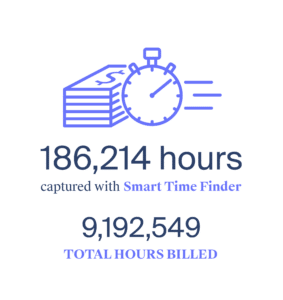
But, as you’ll see below, the 25% of MyCase customers that use Smart Time Finder recorded an additional 186,214 billable hours in 2021.
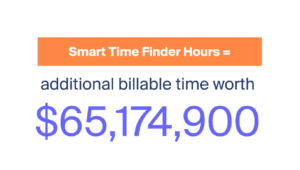
That’s a lot of ‘extra’ time tracked and billed to clients! Assuming a $350 per hour billing rate, MyCase customers who used Smart Time Finder captured additional billable time worth $65,174,900! Each lawyer who used Smart Time Finder billed an extra 25 hours of billable time in 2021, which amounts to another $8,600 invoiced per lawyer.
How Communication Occurs
Another benefit of particular interest to small firm lawyers is the ability to track and view all communications. Practice management software’s communication features memorialize discussions and provide visibility into all law firm interactions. With MyCase, lawyers have many different ways to communicate internally and externally, such as secure client portals, built-in texting, integrated email, and real-time chat.
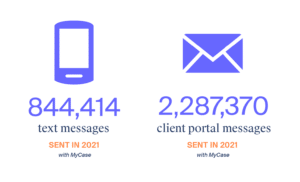
Communication is the key to a strong attorney-client relationship, and our data shows that MyCase customers often communicate with their clients. They used MyCase features to send 844,414 text messages and a whopping 2,287,370 client portal messages in 2021! As you might expect, lawyers from different firms use our communications features quite differently, depending, in part, on their practice areas.
Text Messages
Text messaging is a convenient way to communicate with clients, especially for lawyers handling legal matters on behalf of consumers instead of businesses. MyCase data shows that family and matrimonial attorneys sent the most text messages per case. Due to the nature of their practice areas, they have to interact with clients regarding case-related issues frequently. Additionally, clients don’t always have access to computers but have mobile devices readily available. So texting is often a faster and more convenient way to communicate.
In comparison, lawyers who handle either trust and estate matters or real estate law typically have practices that are primarily transactional. Their clients prefer to communicate in more traditional ways, and as a result, MyCase customers who handle those practice areas sent fewer text messages per case last year.
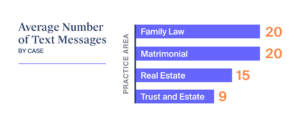
Client Portal Messages
Client portals offer a secure and effective communication option for lawyers seeking to avoid the email altogether. The MyCase client portal offers many benefits, with security being one of them. Many of our customers rely on our client portal for a significant amount of their communications with clients. Once again, family and matrimonial lawyers lead the way in usage due to their increased communication needs.
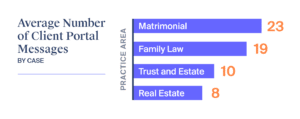
Tracking Tasks and To-Dos
The practice of law is full of deadlines. A large part of managing your practice is managing time and prioritizing tasks. Some tasks are known weeks in advance, and others are unexpectedly added to a long list of to-dos, such as when opposing counsel files a last-minute motion.
Due to these last-minute changes, staying on top of to-do lists and meeting deadlines isn’t easy. It can be extraordinarily frustrating, especially if staying organized isn’t your strong suit. As a result, effective time management is a constant struggle for many legal professionals.
That’s where the time management features in MyCase come into play. As the data below shows, our customers are avid users of the task management features in MyCase.

One way to manage time better and increase productivity in a firm is to create more streamlined processes. Start tracking tasks and never miss a deadline. Our customers often create tasks using MyCase, further assigning them to paralegals and other staff for a quicker turnaround.
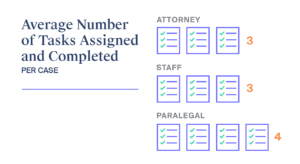
Creating and Sharing Documents
An attorney must be able to create and access their firm’s documents irrespective of where they’re working from. Cloud-based legal document management tools solve this problem by providing a built-in organizational system for documents that is easily accessible from any internet-enabled device.
To further streamline the document creation process, document collaboration, sharing features, and e-signature tools are included in MyCase. This makes it easy to securely share and collaborate on documents with clients, co-counsel, experts, etc.
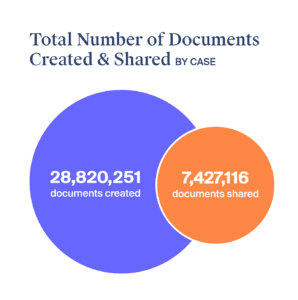
Our customers rely on MyCase’s robust document management feature as you’ll see below. The data indicates that personal injury, matrimonial, and family law firms create the most documents per matter (not surprising since these types of practices can often be document-intensive). In comparison, traffic and criminal defense matters typically involve fewer documents and case filings, so data shows that our customers created fewer documents for such cases.

For the number of documents shared using MyCase, employment law comes in third, with matrimonial and family law firms securing the first and second spot, respectively.
These practice areas involve issues that significantly affect clients’ personal lives. There’s a lot of collaboration with clients in preparation for court appearances using MyCase’s client portal since it’s the most secure way to share confidential documents containing sensitive information.
Trust and estate and real estate lawyers shared far fewer documents per case. Transactional practice areas often require more information collection. But once the information is collected, less document sharing is required to achieve the desired outcome for their clients.
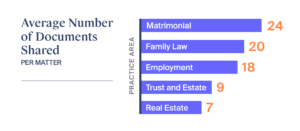
Calendaring Appointments
Next up is legal calendaring. If your firm isn’t already using legal calendaring software with built-in reminder features, you’re at the risk of missing deadlines and appointments, resulting in time and money loss. Another feature that helps to solve the problem of missed appointments is event reminders. Using this feature, which is built into law firm calendar software, lawyers can easily assign tasks and event reminders to other law firm employees as well.
Making Appointments
We also obtained data regarding the number of appointments made per month by all MyCase customers for different practice areas. They varied greatly from one practice area to the next, and the extremes are shared below.
Bankruptcy lawyers scheduled the smallest number of appointments each month. These cases revolve around data collection and litigation in bankruptcy court, but there are only a few required court appearances. For these reasons, there are fewer appointments scheduled in bankruptcy matters.
Other practice areas with fewer appointments each month include trust and estate practices and real estate law. Transactional attorneys rarely, if ever, step foot in a courtroom and information gathering can often occur online. The fact that there are fewer appointments for these practices aligns with expectations. For these practice areas, work is completed by creating documents, not in court or as a result of multiple client meetings.
In contrast, criminal and family law matters require many discussions with clients and involve many court appearances. Hence, there are numerous appointments made each year in MyCase by lawyers who handle those cases.
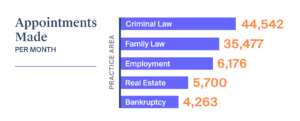
Let’s talk about event reminder tools. Overlooked meetings have become a thing of the past with built-in reminder features. This critical calendaring functionality ensures that everyone is on the same page by allowing lawyers to send task and event reminders to coworkers and clients.

Conclusion
To stay competitive, you need to focus on managing your firm’s activities and streamlining processes. The good news is that technology can make it possible to get work done in your firm efficiently and timely. The key is to ensure you have tools available to support your employees and the practice areas handled by your firm.
Takeaway: Data shows that focusing on your law firm’s processes and implementing suitable productivity features (especially those that are built into law practice management software) will help everyone in your firm to stay on top of tasks.
It will also increase your firm’s efficiency and profitability. The more you understand how the technology you choose will be used in your firm and how it can support your work, the better the end results will be for your firm’s clients.
Get your firm paid faster, improve productivity, and increase client trust. Try MyCase today—risk-free with a 10-day free trial.